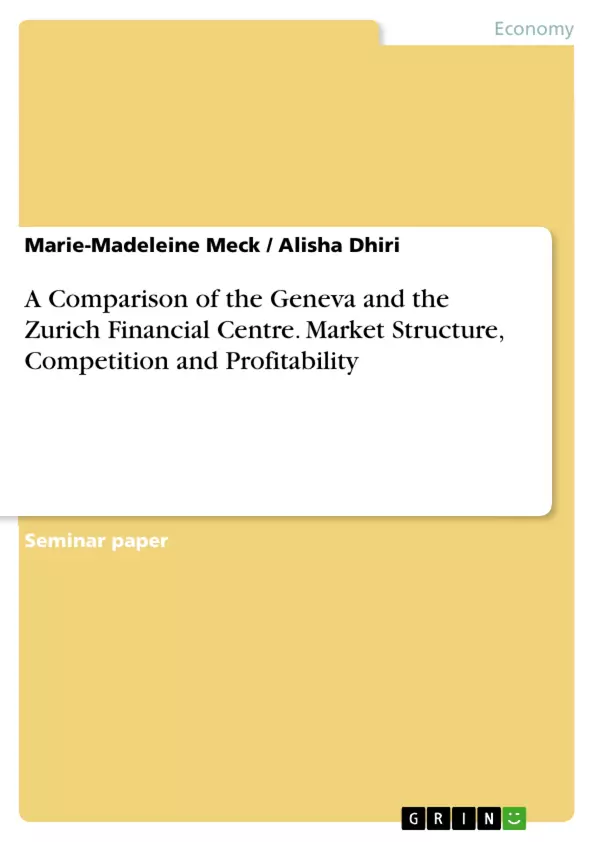Switzerland is one of the most recognised countries for financial services and consists of four main financial centres; Basel, Geneva, Lugano and Zurich. Banking sector can be classified as one of the main contributors in Switzerland’s financial sector.
The following paper addresses two main financial centres in Switzerland as ranked seventh and 13th, respectively by The Global Financial Centres Index: Zurich and Geneva
According to the last GFI report: “The top financial centres of the world are very well developed, sophisticated and cosmopolitan cities in their own right. Successful people are attracted to successful cities and it is perhaps no surprise that these centres are ranked so high by financial services professionals.”
Both financial centres profit from Switzerland’s environment which provides legal stability, and high living-standards and as a result, both financial clusters play an important role in the global business of finance.
This paper aims to analyse the current situation as well to provide an outlook for the future. Due to the limited time as well the limited scope, this paper focuses only on the banking sector, mainly analysing twelve major financial institutions with a strong national presence.
Section 2 covers the background and history of both financial centre, Geneva and Zurich.
Section 3 provides a short overview of the market structure of the financial sector as a whole in each financial centre, describing the number of market participants as well as the offered products and services.
Section 4 contains information regarding the competition in both financial clusters in Switzerland and measures competition using the Herfindahl-Hirschman Index (HHI) on two selected examples.
Section 5 provides an empirical analysis of the profitability of both financial centre using carefully selected key-performance-indicators (KPI).
Lastly, the paper provides an overview as well as an outlook into the future.
Inhaltsverzeichnis (Table of Contents)
- Introduction
- Background and History
- Geneva Financial Centre
- Zürich Financial Centre
- Market Structure
- Geneva
- Number of Financial Institutions
- Products and Services
- Zurich
- Number of Financial Institutions
- Financial Cluster in Banking and Insurances Sector
- Market Entry and Exist
- Geneva
- Competition
- Profitability
- Financial Institutions for Analysis
- Key-Performance-Indicators
- Regression Analysis
- Cost-Income Ratio
- Interest Net Income/Average Assets
- Income from Commissions and Services
- Total Customer Deposit Growth Rate vs. Net New Credit (loans)
- Outlook
Zielsetzung und Themenschwerpunkte (Objectives and Key Themes)
This paper aims to analyze and compare the market structure, competition, and profitability of two major Swiss financial centers: Geneva and Zurich. It focuses on the banking sector, analyzing twelve major financial institutions with a strong national presence. The paper also provides an outlook for the future of these financial centers.
- The historical development and current status of the Geneva and Zurich financial centers.
- The market structure of the banking sector in both financial centers, including the number of financial institutions and the products and services offered.
- An analysis of competition in the banking sector using the Herfindahl-Hirschman Index (HHI).
- The profitability of the two financial centers, based on key performance indicators (KPIs) such as the cost-income ratio, interest net income, and commission income.
- A future outlook for the Geneva and Zurich financial centers.
Zusammenfassung der Kapitel (Chapter Summaries)
- Introduction: The paper introduces the two financial centers in Switzerland: Zurich and Geneva, both ranked highly by the Global Financial Centres Index. The paper then explains the objective of the study and the focus on the banking sector.
- Background and History: This section delves into the historical development of both financial centers. It highlights the role of Geneva as a trade hub, its early adoption of lending at interest, and its development as a global trading place. The section also outlines the key stages in Zurich's growth as a financial center, including the establishment of its stock exchange and its increasing focus on wealth management and asset management.
- Market Structure: This section examines the market structure of the banking sector in both financial centers. It analyzes the number of financial institutions and the range of products and services they offer, providing insights into the competitive landscape. This section also discusses the ease of entry and exit in the market.
- Competition: This section examines the competitive dynamics within the banking sector of both financial centers. It explores the use of the Herfindahl-Hirschman Index (HHI) to measure concentration in specific market segments.
- Profitability: This section investigates the profitability of the banking sector in both financial centers. It examines key performance indicators (KPIs) such as the cost-income ratio, interest net income, and income from commissions and services. It aims to provide a quantitative analysis of the financial performance of the institutions within each center.
Schlüsselwörter (Keywords)
The paper focuses on the banking sector, analyzing the market structure, competition, and profitability of the Geneva and Zurich financial centers. Key terms include: banking sector, market structure, financial institutions, products and services, competition, Herfindahl-Hirschman Index, profitability, key performance indicators, cost-income ratio, interest net income, income from commissions and services, and future outlook.
- Quote paper
- Marie-Madeleine Meck (Author), Alisha Dhiri (Author), 2016, A Comparison of the Geneva and the Zurich Financial Centre. Market Structure, Competition and Profitability, Munich, GRIN Verlag, https://www.grin.com/document/315808



